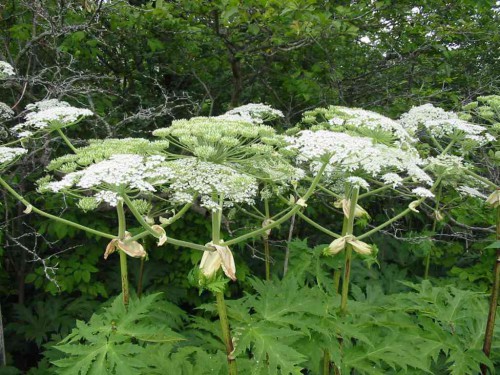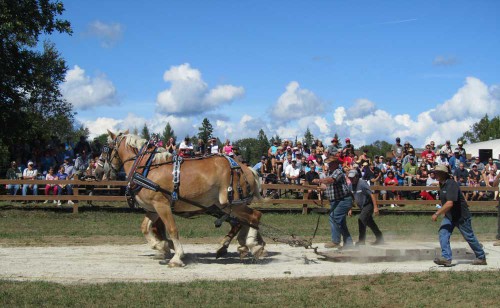Experts suggest strategies for control, containment
MANITOULIN––Forces are being marshaled and battle lines drawn in the latest alien invasion of Manitoulin’s shores. Patches of phragmites australis and heracleum mantegazzianum are swarming onto Island beaches and lurking about Manitoulin’s fields, ditches and wetlands, coming as hitchhikers on boats and campers and dropped unwittingly along our byways by those vehicles’ erstwhile and unwitting owners.
These alien invaders are intent on subverting the native flora and establishing their own noxious communities among us-but it’s not by malevolent design; it’s just in their natures.
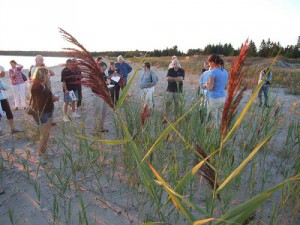 More familiar monikers attached to these perfidious invaders would be the ‘invasive common reed’ and ‘giant hogweed.’ Manitoulin Area Stewardship Council coordinator Mary Ellen Shain drafted both local and outside experts to deliver a seminar at the Providence Bay community centre aimed at assisting and enlisting Manitoulin residents in the battle to drive back these unwanted intruders. Ontario Ministry of Agriculture, Food and Rural Affairs representative Brian Bell and Karen Alexander, education and outreach coordinator at The Coastal Centre, an NGO engaged in Great Lakes coastal conservation, came to the centre to fill in the full house crowd that came out for the presentation last Tuesday.
More familiar monikers attached to these perfidious invaders would be the ‘invasive common reed’ and ‘giant hogweed.’ Manitoulin Area Stewardship Council coordinator Mary Ellen Shain drafted both local and outside experts to deliver a seminar at the Providence Bay community centre aimed at assisting and enlisting Manitoulin residents in the battle to drive back these unwanted intruders. Ontario Ministry of Agriculture, Food and Rural Affairs representative Brian Bell and Karen Alexander, education and outreach coordinator at The Coastal Centre, an NGO engaged in Great Lakes coastal conservation, came to the centre to fill in the full house crowd that came out for the presentation last Tuesday.
The matter is very serious as these invading species tend to choke out the local and native species and, in the case of giant hogweed, present a toxic danger for humans who are unfortunate enough to have their skin contaminated by the plant’s sap. The common reed is overwhelming fields even in its home ranges, and is the more pernicious and persistent of the two.
Ms. Alexander pointed out that the common reed evolved in an environment where it was heavily grazed, and in response developed a reproductive system heavily dependant on rhizomes, shoots hidden deep underground that can stretch for up to eight feet, matching or even exceeding its eight-foot height above ground. Although the plant also produces seed heads and spreads that way as well, it is the small bits and chunks of the plant itself that, like the nine-headed hydra of Greek legend, sprout up through runners emanating from the mother plants.
The giant hogweed plant gains the ‘giant’ moniker from its towering eight-foot plus mature height, but stands usually contain several generations of the plant in all stages of development. Giant hogweed is described as a ‘short lived’ perennial weed that only reproduces by seed, and is usually found along rivers, streams and wetland areas, but it can also be found in pasturelands, a trait it shares with the common reed. The most successful tactic for dealing with hogweed is containing and limiting its seed production-but because of its nasty oil, stringent precautions must be taken to avoid contact. The oil tends to interact with sunlight causing severe burns on human skin.
Mr. Bell was the lead presenter on the giant hogweed, and he noted that he has seen several patches on Manitoulin. Mr. Bell directed attendees to the excellent OMAFRA websites on giant hogweed including www.ontario.ca/hogweed , weedinfo.ca or the Ontario weeds directory at www.omafra.gov.on.ca.
Mr. Bell noted that exposure to the oil of the giant hogweed can lead to a long-term photosensitivity that may last for several years following the extreme rash that can break out on exposed human skin.
The plant grows rapidly and looks somewhat similar to the wild carrot or Queen Anne’s Lace, only in a much larger format. “It is not uncommon for it to grow one to one-and-a-half feet a week,” said Mr. Bell. That is its most discerning departure from wild carrot. “If the plant is flowering at only one or two feet in height, it is not giant hogweed,” he said.
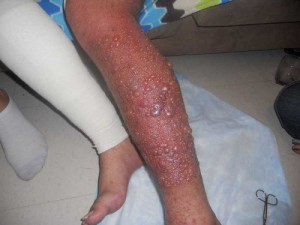 The more disturbing thing about giant hogweed on Manitoulin is the tendency for the weed to show up in places with which it is not usually associated. The weed is found in smaller patches right now, making early detection and remediation both effective and desirable.
The more disturbing thing about giant hogweed on Manitoulin is the tendency for the weed to show up in places with which it is not usually associated. The weed is found in smaller patches right now, making early detection and remediation both effective and desirable.
“The seeds do not last very long,” said Mr. Bell. “Unlike ragweed, which can last in the soil for up to 40 years, giant hogweed seeds do not remain viable much past three or four years.”
Unfortunately, giant hogweed is rarely predated upon by grazing animals such as deer or cattle because of its toxicity-animals just don’t cotton to the taste.
One of the effective means of dealing with giant hogweed for a homeowner is a product commercially known as Roundup. “Agriculturalists can use other more concentrated forms of Roundup,” said Mr. Bell.
Mr. Bell noted that in purchasing products like Roundup, it is up to the person purchasing and using the substance to pay close attention to the label. Under the regulations, the label of the product is a legal document, and variation or diversion from the handling instructions and precautions can lead to prosecution and fines. “It is a legally binding document,” said Mr. Bell. “I can’t stress that enough. If it says 15 metres from water you have to abide by that-you have to watch that and 15 metres is about 40 feet.
The most effective means of dealing with giant hogweed is controlling the seeds. “You have to control the seed set,” said Mr. Bell. “When you have a patch with mature hogweed towering up over your head, there is no way you can go in and fix it with a one-shot deal.”
Persistence and vigilance can pay off, however.
“The key thing is to get on it early,” said Mr. Bell. “Start in mid-to-late April.” The plant takes three years to grow to maturity.
Mr. Bell showed a number of short videos featuring Mike Cowbrough, an OMAFRA plant expert, to help people identify giant hogweed. Those videos can be found online at the OMAFRA website. Although there are many plants, such as cow parsnip, that resemble giant hogweed, there are some clearly identifiable aspects that make giant hogweed stand out. Specifically, coarsely-haired stems with dark purplish patches and jagged maple-leaf-like leaves.
The University of Guelph has conducted in-depth research into giant hogweed, setting up a patch of 300 seedlings to test various strategies to deal with the plant. One that is showing promise in dealing with larger plants is injecting the hollow stems of the adult plant with a compound that kills the plant before the seed heads come to maturity. “It disrupts the seed production,” said Mr. Bell.
What is clear from the studies is that control will be a multi-year process and that mechanical control is among the most effective approaches.
In answer to a question about what to do with the plant material left over from mechanically gathering up the plant bodies and roots, Mr. Bell stressed that incineration is not advisable. “Burning is not recommended,” he said. “You could bring the toxins into your lungs.” Instead, he advised placing the plant material into garbage bags and placing it in the landfill.
It is very important to wear safety equipment before attempting to handle the plant. “Eye protection, a rainsuit, rubber gloves-the long heavy industrial kind that go up the arms, not your kitchen dishes variety, and good rubber boots,” suggested Mr. Bell.
Unfortunately, if the plant is found on private land, it is, by law, the landowner’s responsibility to deal with the weed. “We can provide guidance,” said Mr. Bell. “But we are not going to come out and deal with it for you.”
Municipalities are responsible for stands found on their property but again they are unlikely to deal with it on behalf of the landowner, although they might force the issue and deal with it under property standards bylaws and send the landowner the bill.
The common reed is a less toxic, but in some ways more difficult weed to control, explained Ms. Alexander. The plant’s similarity to an indigenous plant, another common reed, meant the plant flew under the radar for many years before its invasive and pervasive nature was recognized. Because it was miss-classified as a natural resident, the plant was even aided in its dispersal by road and highway departments who planted it alongside road construction projects to stabilize the sides of roadways from erosion.
By the time it was recognized that the plant was not native to North America, it had traveled from its first landing as elephant bedding for circus animals on the eastern seaboard to the shores of the Great Lakes and into the prairies beyond.
The invasive common reed is a pretty and decorative plant, whose beauty belies its sinister nature. The top of the plant produces a seed head with wispy strands of deep blue-green seeds and tends to grow in very dense patches.
Therein lies its negative impact on both native animal and plant life.
“The stands are so thick that small aquatic animals like the endangered banded turtle can’t navigate through to the water,” said Ms. Alexander.The recent long term decline in water levels has given the invasive common reed an uncommon advantage in establishing itself along coastlines of the Great Lakes. As part of the natural cycle of high and low water marks, seeds from natural aquatic plants are buried for years in the mud below the surface of the water when high water floods the lowland shores. As the water recedes in low water portions of the cycle, the flooded seeds spring into action and begin to grow. But with low water levels lasting longer than normal, and dropping far more than usual, the shoreline extends into areas without buried viable seeds-producing an ideal pristine bed for the common reed to establish itself.
Once the reed begins to grow, it emits a chemical into the ground that discourages other plants from growing.
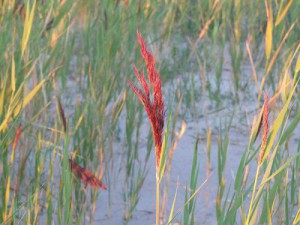 A suggestion from Providence Bay resident Lyle Dewar that he bring a tractor down to the Providence Bay beach and combine the reed was met with immediate horror and a quick admonition against any such strategy from Ms. Alexander. Aside from the damage to fragile dune grasses-”It only takes 200 steps on the grass to kill the plant,” cautioned Ms. Alexander-the tractor and combine would likely spread small pieces of the plant all the way down the beach.
A suggestion from Providence Bay resident Lyle Dewar that he bring a tractor down to the Providence Bay beach and combine the reed was met with immediate horror and a quick admonition against any such strategy from Ms. Alexander. Aside from the damage to fragile dune grasses-”It only takes 200 steps on the grass to kill the plant,” cautioned Ms. Alexander-the tractor and combine would likely spread small pieces of the plant all the way down the beach.
Digging up the plant roots isn’t much of an option, as it only takes a tiny portion of the plant for it to generate another version of itself. Controlling the seed head is not so much of an option, as the plant’s primary form of reproduction is through its runners.
Chemical attacks on the plant are hampered by the common reed’s preference for regions like wetlands, drains and other near-water body environments.
“I wish I had a one-stop fix for all of the people here, (but) I don’t,” said Ms. Alexander, as she acknowledged that there are few effective strategies for dealing with the weed. “It is going to take people making this a priority.”
The best course of action appears to be putting together groups of volunteers and/or school children to go out to the stands and cut the seed heads off of the plants and disposing of them.
“It will not get rid of the stand, but it will help to contain it and the usual result is that the stand gets thicker,” she said. “The best time to cut the seeds is mid-August.”
Following the presentation, a group of about 60 attendees walked down the boardwalk to the Providence Bay beach to take a close look at a stand of the invasive common reed and continue the discussion of strategies to deal with them.
Ms. Alexander advised Manitoulin communities to come together in an Island-wide response to invasive species. “The best practice in this regard would be to pool resources,” she said.
There are some chemical options on the horizon for dealing with invasive plantlife, including a form of Roundup that does not contain the binding ingredient that makes the current form so lethal to aquatic life-but Ms. Alexander surmised that it will take at least five years before it may be available in Canada. Part of the issue is that the Canadian market is not worth the cost of meeting Canadian standards and regulatory hurdles.

